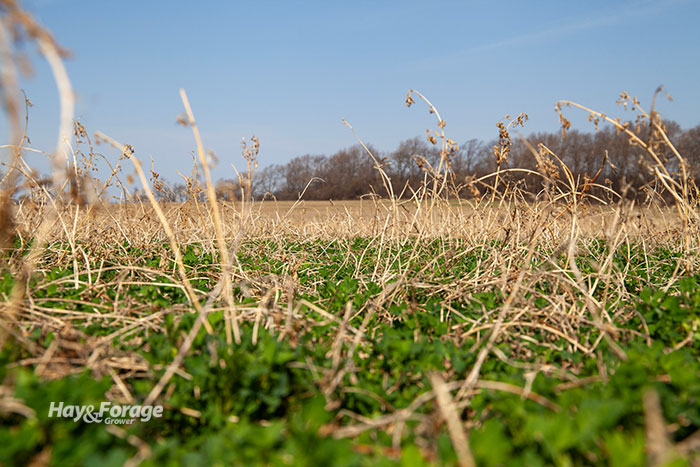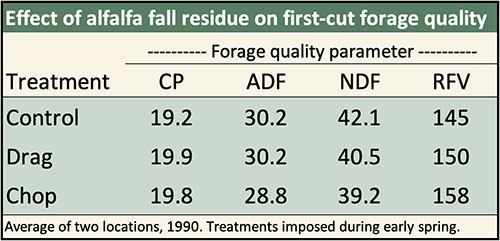What does fall regrowth do to first-cut quality? |
| By Mike Rankin, Managing Editor |
|
|
 One of the reasons Northern alfalfa producers sometimes like to take a late cutting of alfalfa is to keep that brown, stemmy, overwintered fall regrowth from potentially lowering the quality of the next year’s first cutting. At the same time, cutting during the late fall slows spring regrowth, reduces first-cut yield, and potentially could result in winterkill. “What is the impact of this residue on my first cutting?” was one of the first questions asked of me soon after I took a job as a Wisconsin county extension agent in the late 1980s. At that time, I wasn’t really able to find any definitive answer. Yet, we had some producers who didn’t like cutting in late fall but would still go out in early spring and flail chop the overwintered residue without knowing if it was worth the effort or not. With no university research to address this issue at the time, I set up a replicated on-farm trial in two fields with abundant remaining fall growth. The treatments were to do nothing, knock the residue down by pulling a drag (tines up) over the brown residue in the spring while the ground was still frozen on top, or chop the standing residue into fine pieces, which simply remained lying on the ground. This was done at two locations. At the time of first cutting, the plots were harvested with a conventional pull-type chopper and the forage samples were analyzed. The results are presented in the table below.  The effects of fall aftermath growth on forage quality will be greater in early cut alfalfa compared to later cut forage. In the above study, the alfalfa was cut soon after buds appeared. In a later cutting, there would be more of a dilution effect. Note that removing the fall residue had an impact on forage quality, but it wasn’t significant. As might be expected, the drag treatment was intermediate in quality between the control and chopping. Aside from forage quality considerations, there are also some agronomic ones associated with driving on alfalfa stands in early spring. When fields are frozen or wet, there is the possibility of causing crown damage to alfalfa plants. During most springs, there is usually only a narrow timeframe to manipulate residue, and it has to be done before plant regrowth begins. Although removing fall residue in the spring may result in slightly higher forage quality, we decided it was small enough that risking damage to fields during that time of year wasn’t worth the effort. The economics of such a practice is also questionable unless dry hay is being marketed for retail or to horse customers who may object to seeing the brown residue. |
